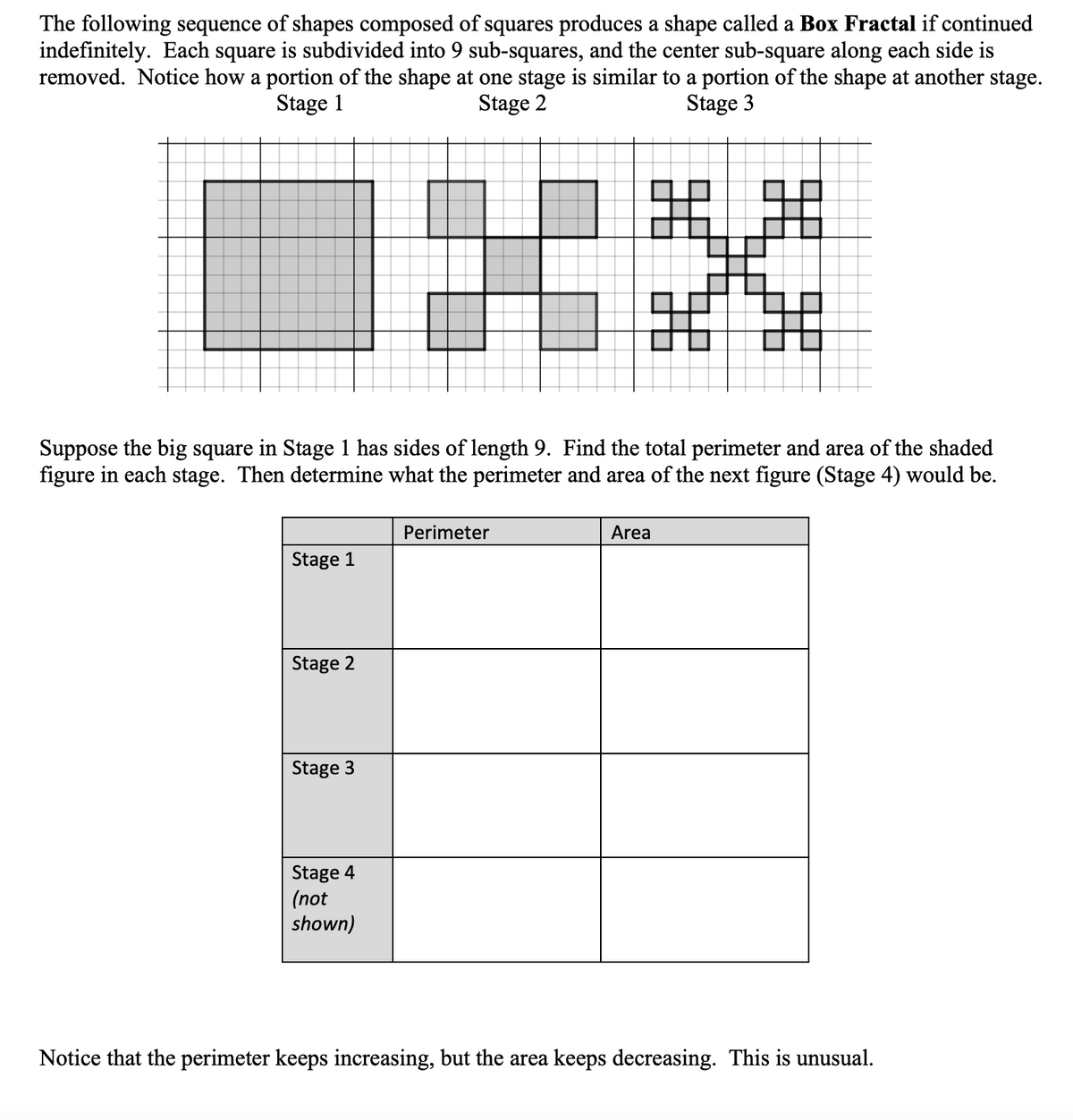The following sequence of shapes composed of squares produces a shape called a Box Fractal if continued indefinitely. Each square is subdivided into 9 sub-squares, and the center sub-square along each side is removed. Notice how a portion of the shape at one stage is similar to a portion of the shape at another stage. Stage 1 Stage 2 Stage 3 Stage 1 Suppose the big square in Stage 1 has sides of length 9. Find the total perimeter and area of the shaded figure in each stage. Then determine what the perimeter and area of the next figure (Stage 4) would be. Stage 2 Stage 3 Stage 4 (not shown) H Perimeter H Area
The following sequence of shapes composed of squares produces a shape called a Box Fractal if continued indefinitely. Each square is subdivided into 9 sub-squares, and the center sub-square along each side is removed. Notice how a portion of the shape at one stage is similar to a portion of the shape at another stage. Stage 1 Stage 2 Stage 3 Stage 1 Suppose the big square in Stage 1 has sides of length 9. Find the total perimeter and area of the shaded figure in each stage. Then determine what the perimeter and area of the next figure (Stage 4) would be. Stage 2 Stage 3 Stage 4 (not shown) H Perimeter H Area
Algebra & Trigonometry with Analytic Geometry
13th Edition
ISBN:9781133382119
Author:Swokowski
Publisher:Swokowski
Chapter10: Sequences, Series, And Probability
Section: Chapter Questions
Problem 63RE
Related questions
Question

Transcribed Image Text:The following sequence of shapes composed of squares produces a shape called a Box Fractal if continued
indefinitely. Each square is subdivided into 9 sub-squares, and the center sub-square along each side is
removed. Notice how a portion of the shape at one stage is similar to a portion of the shape at another stage.
Stage 1
Stage 2
Stage 3
Stage 1
Suppose the big square in Stage 1 has sides of length 9. Find the total perimeter and area of the shaded
figure in each stage. Then determine what the perimeter and area of the next figure (Stage 4) would be.
Stage 2
Stage 3
Stage 4
(not
shown)
H
Perimeter
=
Area
Notice that the perimeter keeps increasing, but the area keeps decreasing. This is unusual.
Expert Solution
This question has been solved!
Explore an expertly crafted, step-by-step solution for a thorough understanding of key concepts.
Step by step
Solved in 3 steps with 3 images

Recommended textbooks for you

Algebra & Trigonometry with Analytic Geometry
Algebra
ISBN:
9781133382119
Author:
Swokowski
Publisher:
Cengage

Linear Algebra: A Modern Introduction
Algebra
ISBN:
9781285463247
Author:
David Poole
Publisher:
Cengage Learning

Algebra & Trigonometry with Analytic Geometry
Algebra
ISBN:
9781133382119
Author:
Swokowski
Publisher:
Cengage

Linear Algebra: A Modern Introduction
Algebra
ISBN:
9781285463247
Author:
David Poole
Publisher:
Cengage Learning